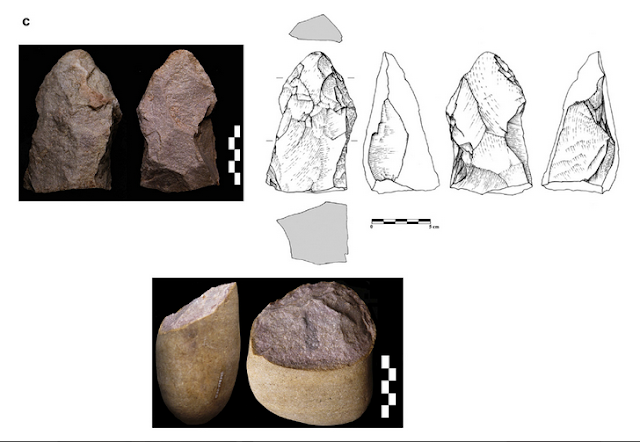New Year's first day, and I had some time on my hands to browse the web reading my favorite subject: the early peopling of America.
Favorite because: early peopling of Americas by H. sapiens or other hominids - archaic humans could have been the original source of "wild men", "bigfoot" and "giants" in later arrivals such as Paleoindians.
I came across a very interesting archaeological site, in northeastern Brazil, well dated and very very old for American standards.
In the past I posted about ancient sites in Brazil (see: Homo Erectus tools found next to Rio de Janeiro, Homo erectus in Brazil: Itaboraí Basin. and H. erectus in Brazil: Toca da Esperanca Site), all of which are either "contested" by orthodoxy (incorrectly dated, natural and not man-made artifacts, etc.) or ignored.
Toca da Tira Peia site
The paper by Lahaye, describes the use of luminescence techinques in dating stone artifacts from the Toca da Tira Peia site which "bring new pieces of evidence of a human presence in the north-east of Brazil as early as 20,000 BC. The Toca da Tira Peia thus contributes to the rewriting of the history of the peopling of the American continent" (Lahaye, 2013).
I believe that it will indeed force some rethinking on the peopling of America if the 20 kya date stands up to the barrage it will receive from "conservative" scientists.
This rock shelter in Piaui, Brazil was discovered in 2008. A total of 113 knapped stone tools have been retrieved from it. They come from four layers which have been dated from 4 to 22 kya.
The tools are of an unquestionable human origin (no geofacts here) and techniques employed in dating them (luminescence) are commonly used to date Asian and European stone tools.
The images below are from Lahaye et al.'s paper:
Their caption for the image is (quote): Fig. 5.
Lithic artifacts from Toca da Tira Peia.
a) Artifacts on quartzite pebbles from level C4.
b) Up: layer C6a convergent retouched edges tool on quartzite pebble. Down: layer C6a denticulate tool on siliceous limestone flake (retouched on lower face).
c) Artifacts on quartzite pebble from the C7a layer. Up: Bifacially shaped tool.
To my layman's eye, these stone artifacts are very crude looking, quite different from Clovis points or other lithic tools found in younger layers in South America.
They look Oldowan to me. (check these tools and compare them to those found in Africa fashioned by Homo habilis). Take the top tool in the link and compare it with the tool shown in "c" above in the bottom part of the image. They are identical
Pedra Furada site
The site is in the same National Park (Serra da Capivara Park) as the Pedra Furada (Portuguese for Drilled or Perforated stone, there is a stone arch in the park) site.
Pedra Furada site has yielded stone tools and hearths whose ashes have been dated to +32 kya (Guidon and Delibrias, 1986). The dates are controversial and the tools and ashes are deemed to be geofacts and not man-made (Meltzer, Adovasio and Dillehay, 1994).
The cost of stubbornness
The case is that both sites (and others found in South America) disprove the Clovis first theory and propose a more ancient origin for the arrival of humans to America, but Clovis advocates refuse to budge.
This in turn forces geneticists to underestimate the timing of human entry into America, so they tune the genetic mutations to the tune of incorrect archaeological findings (incorrect because they ignore these "old" sites), therefore the clock is wrong and the assumptions based on it are also wrong.
So when I read that since humans arrived in America about 15 kya, then their ancestral population in Eastern Asia must be about 20-25 kya and.... so forth, I wonder what the implications would be if instead the geneticists assumed a 50 kya date for arrival in America (similar to the arrival date in Australia)... Their Asian ancestors would date back to about 60 kya... and that would change the picture quite a bit.
My next post will be about some tools and bones cut with them in Uruguay, dating back to 32 kya.
Sources
Guidon, Niède y G. Delibrias. 1986 "Carbon-14 dates point to man in the Americas 32 000 years ago"; Nature 321: 769-771
Meltzer, David, Adovasi, James and Dilehay Tom. (1994), On a Pleistocene human occupation at Pedra Furada, Brazil. Antiquity 68(261):695714. 1994
Christelle Lahaye, 2013. Human occupation in South America by 20,000 BC: the Toca da Tira Peia site, Piauí, Brazil. Journal of Archaeological Science, Volume 40, Issue 6, June 2013, Pages 2840–2847
Patagonian Monsters - Cryptozoology, Myths & legends in Patagonia Copyright 2009-2014 by Austin Whittall ©


















Hello, Happy New Year from Germany - some thoughts once more ;-)
ReplyDelete"Clovis first" is out since 40 years now, Clovis = Solutreen (Cro-Magnons from France came across the Atlantic), but they were not the first.
"Bering-Theory" we bring into ridicule since 30 years - it was a migration of some North-Canadian-Indians into Siberia long after the peopling of America, modern Sapiens from both sides coming across the sea (Cro-Magnon and South-East-Asians).
As for Archaic-Sapiense or earlier types there are some theories :
Some kind of Australians - from Australia or direct "out-of-Africa" ?
Late H.Erectus (H.Heidelbergensis) - from Europe or Asia ? H.Steinheimensis ?? Rumours of tools and a kill-site -250ka ..
Best regards and keep up the good work :-)